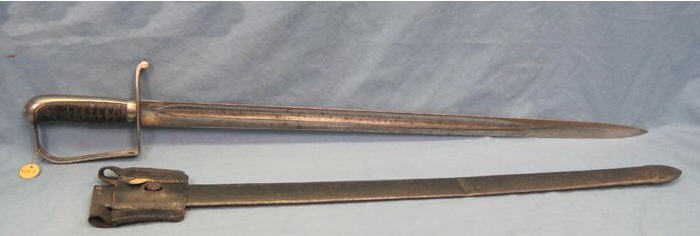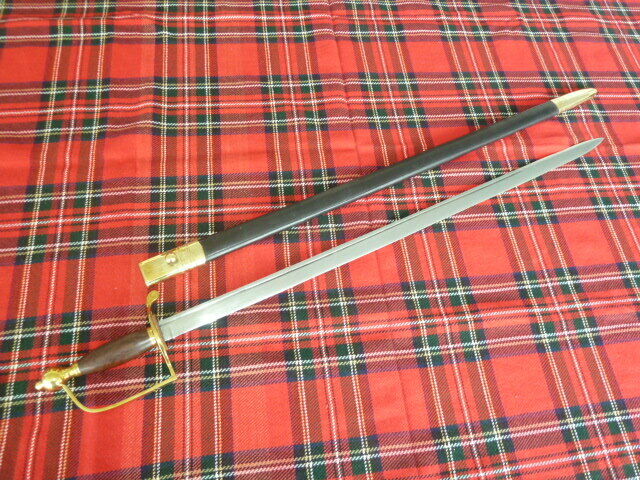As I understand it, the main infantry sword for much of the 16th and 17th centuries in Western Europe was the tuck or estoc, only able to thrust, while infantry in the 18th century mostly carried 'hangers' with broad, curved cutting blades. When did this transition occur, and what were the ancestors of the hanger?
I was trying to look into this myself, trying to figure out what a "tuck" of the English Civil War pike man looked like, and what I found was that hangers were used in the 1600's and used as sidearms by infantry, but never found an example of the thrusting tuck, which I'd like to see.
I'd imagine from this that they were contemporary and the tuck was slowly abandoned over time, but that just an assumption from light reading.
I'd imagine from this that they were contemporary and the tuck was slowly abandoned over time, but that just an assumption from light reading.
I could be totally wrong on this but I think the word tuck, when used in the context of a 16th or 17th century infantry sword, was just another term for a hanger. The confusion lies in the fact that an estoc was also sometimes called a tuck.
| Stephen Curtin wrote: |
| I could be totally wrong on this but I think the word tuck, when used in the context of a 16th or 17th century infantry sword, was just another term for a hanger. The confusion lies in the fact that an estoc was also sometimes called a tuck. |
I'm pretty sure this is the case, searching online museum archives, you can find a few examples of things called a "tuck" that are thrusting swords of the period, but sometimes swords attributed to pikemen are just hangars, or even broad or backswords, but most are simply called "sword", rather than being given a specific name, which I guess is to be expected.
They were all used at the same time, and probably all called a tuck by the fact they were being used by infantry.
Some examples of some of the stuff I found in a brief search, only one sword being called a tuck in the Royal Armouries isn't particularly helpful, but it fits the bill of what the is supposed to mean exactly, I'd love to see some more examples specifically referred to as a "tuck"
https://collection.nam.ac.uk/detail.php?acc=1964-08-34-5
https://collection.nam.ac.uk/detail.php?acc=1974-10-197-1
https://collections.royalarmouries.org/object/rac-object-6993.html
why were tuck estocs even called tucks anyways?
was it due to the aspect of estocs being 'tucked' under the arm as a backup lance?
was it due to the aspect of estocs being 'tucked' under the arm as a backup lance?
| William P wrote: |
| why were tuck estocs even called tucks anyways?
was it due to the aspect of estocs being 'tucked' under the arm as a backup lance? |
According to the OED, just an anglicization of the French estoc (which in Norman French was apparently etoc)
Tuck in the sense of "tuck under the arm" isn't recorded until later than the sword, apparently. The tailoring term is earlier though.
Deepeeka has a pre "hanger" tuck
http://deepeeka.in/english-tuck-sword.html
The short straight blades were favored by the French until the briquet sabres with cast grips. Both double and single edge.
The US made good use of short backsword blades with nco swords from both Rose and Starr from the early 19th century until the 1820s and beyond.
Cheers
GC
 Attachment: 45.39 KB
Attachment: 45.39 KB

Sabre Troupes Marine
Half hilt
 Attachment: 21.96 KB
Attachment: 21.96 KB

Starr 1818
 Attachment: 130.97 KB
Attachment: 130.97 KB
Rose brief [ Download ]
http://deepeeka.in/english-tuck-sword.html
The short straight blades were favored by the French until the briquet sabres with cast grips. Both double and single edge.
The US made good use of short backsword blades with nco swords from both Rose and Starr from the early 19th century until the 1820s and beyond.
Cheers
GC

Sabre Troupes Marine
Half hilt

Starr 1818
Rose brief [ Download ]
| Glen A Cleeton wrote: |
| Deepeeka has a pre "hanger" tuck
http://deepeeka.in/english-tuck-sword.html The short straight blades were favored by the French until the briquet sabres with cast grips. Both double and single edge. The US made good use of short backsword blades with nco swords from both Rose and Starr from the early 19th century until the 1820s and beyond. Cheers GC |
That Deepeeka doesn't look particularly great, and isn't something anyone should base any knowledge off of.
I think things like the smallsword/spadroon and shorter backswords in later use are at least adjacent to the tuck or the hanger if not directly related, but it's a good point that smaller thrusting swords never really went out of use with the infantry.
| George B wrote: | ||
That Deepeeka doesn't look particularly great, and isn't something anyone should base any knowledge off of. I think things like the smallsword/spadroon and shorter backswords in later use are at least adjacent to the tuck or the hanger if not directly related, but it's a good point that smaller thrusting swords never really went out of use with the infantry. |
There is a review on Kult of Athena and the Mayflower Militia seems impressed. I know English retailers carry the sword. It is a Deepeeka after all though. I find the form plausible, without looking for the true counterpart. SKU: AH3422
Capt J. – June 1, 2018 (five stars)
Mayflower Militia Sword The English Half-Basket Hanger is the perfect sword for the an armed musketeer that were part of the militia of the Pilgrims that land in 1620. As commander of the Mayflower Guard I recommend this item for Pilgrim militia living history particiapnts.
I've watched the Deepeka for years and it would currently be $123 usd (including tax) from KOA to my door.
I own both a sister of the 1750s French sword pictured and that is my Starr 1818 above. I did buy a repro of the Rose swords which is very close to true and with the longer blade of this auction. Owing many period swords, I am quite impressed with this India made reproduction.
https://www.lotsearch.net/lot/rare-rose-non-commissioned-artillery-officers-sword-with-scabbard-48371777?page=5
Having owned many spadroons, these short and wider blades aren't really spadroons but what's in a name. Here is also an old picture of my French hanger with longer spadroons. The short sword on our right is a US Marines musician boy sword.
Cheers
GC
Something period
http://civilwaroriginalperioditems.com/c_1640...rapier.htm

Rose reproduction
Some straight stuff [ Download ]
As I understand it, tucks weren't a particularly common infantry weapon through the 17th century-they seem to have used the usual assortment of cut-and-thrust swords, hangers, backswords, the occasional rapier etc. as sidearms. I think the idea of tucks as an infantry sidearms comes from military manuals like the Duke of Albemarle, where he wanted all soldiers(cavalry got long tucks, infantry got tucks "not too long") to carry tucks out of frustration with them wrecking the edges of their swords using them to chop firewood. All the antique tucks I'm aware of are quite long and seem to be either edgeless rapiers or the western European equivalent of a koncierz.
Page 1 of 1
You cannot post new topics in this forumYou cannot reply to topics in this forum
You cannot edit your posts in this forum
You cannot delete your posts in this forum
You cannot vote in polls in this forum
You cannot attach files in this forum
You can download files in this forum
All contents © Copyright 2003-2006 myArmoury.com — All rights reserved
Discussion forums powered by phpBB © The phpBB Group
Switch to the Full-featured Version of the forum
Discussion forums powered by phpBB © The phpBB Group
Switch to the Full-featured Version of the forum